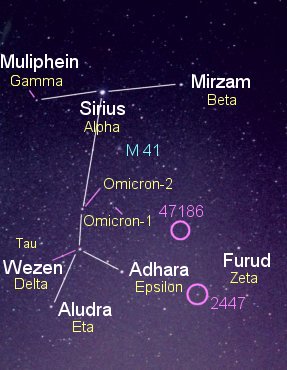 HD 47186, while quite faint and well out of naked-eye range, is a
breakthrough star in that it is was of three with "superearths"
that were announced in 2008. Of the three, it has the largest
"superearth planet" (in addition to a larger one), which comes in
at a minimum of 0.0717 Jupiter masses, or 23 Earth-masses. (HR
40307 in Pictor has three planets with minimum masses of 4.2, 6.9,
and 9.2 Earth masses in tight orbits with respective periods of
4.31, 9.62, and 20.5 days, while HD 181433 has a planet of 7.6
Earth masses in an orbit of 9.37 days, in addition to a larger,
more Jupiter-like planet.)
HD 47186, while quite faint and well out of naked-eye range, is a
breakthrough star in that it is was of three with "superearths"
that were announced in 2008. Of the three, it has the largest
"superearth planet" (in addition to a larger one), which comes in
at a minimum of 0.0717 Jupiter masses, or 23 Earth-masses. (HR
40307 in Pictor has three planets with minimum masses of 4.2, 6.9,
and 9.2 Earth masses in tight orbits with respective periods of
4.31, 9.62, and 20.5 days, while HD 181433 has a planet of 7.6
Earth masses in an orbit of 9.37 days, in addition to a larger,
more Jupiter-like planet.)
THE PLANETS
The upper circle shows the location of the class G7 dwarf star HD
47186 in the constellation Canis Major,
which has two planets, one quite small. The planets orbit their
star with periods of 4.08 days and 3.7 years with (assuming the
star to have a mass of 0.9 times that of the Sun) orbital sizes of
0.05 and 2.3 Astronomical Units. Lower limits to the masses are
estimated at 0.0717 and 0.35 times that of Jupiter (23 and 111
times that of Earth. The system thus appears vaguely like our own
Solar System, with an inner smaller planet 12 percent Mercury's
distance from the Sun and a more Jovian one about where our
asteroid belt would be.
|
 HD 47186, while quite faint and well out of naked-eye range, is a
breakthrough star in that it is was of three with "superearths"
that were announced in 2008. Of the three, it has the largest
"superearth planet" (in addition to a larger one), which comes in
at a minimum of 0.0717 Jupiter masses, or 23 Earth-masses. (HR
40307 in Pictor has three planets with minimum masses of 4.2, 6.9,
and 9.2 Earth masses in tight orbits with respective periods of
4.31, 9.62, and 20.5 days, while HD 181433 has a planet of 7.6
Earth masses in an orbit of 9.37 days, in addition to a larger,
more Jupiter-like planet.)
HD 47186, while quite faint and well out of naked-eye range, is a
breakthrough star in that it is was of three with "superearths"
that were announced in 2008. Of the three, it has the largest
"superearth planet" (in addition to a larger one), which comes in
at a minimum of 0.0717 Jupiter masses, or 23 Earth-masses. (HR
40307 in Pictor has three planets with minimum masses of 4.2, 6.9,
and 9.2 Earth masses in tight orbits with respective periods of
4.31, 9.62, and 20.5 days, while HD 181433 has a planet of 7.6
Earth masses in an orbit of 9.37 days, in addition to a larger,
more Jupiter-like planet.)